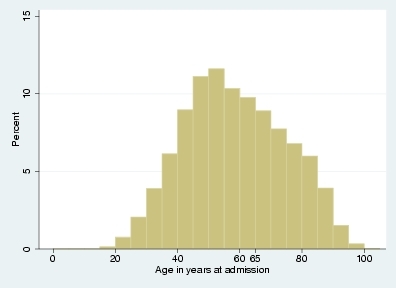|
Back to Annual Meeting Posters
Emergency Department Presentation, Admission and Surgical Intervention for Colonic Diverticulitis
Eric B. Schneider*1, Aparajita Singh2, Shalini Selvarajah1, Jonathan E. Efron1, Anne O. Lidor1
1Surgery, Johns Hopkins University School of Medicine, Baltimore, MD; 2Gastroenterology, University of California, San Francisco, San Francisco, CA
Background:
Most previous population-based studies of diverticulitis are limited to patients aged 65 years and older. Using a nationally representative sample of emergency department (ED) visits, we sought to describe ED presentation and outcomes among patients of all ages with a primary diagnosis of diverticulitis.
Methods: In a retrospective cross-sectional study, the 2009 Nationwide Emergency Department Sample was queried and patients presenting with a primary diagnosis of colonic diverticulitis were isolated. Demographic variables admission to inpatient status and surgical intervention were compared between patients younger than 65 vs. those 65 or older. Standard descriptive statistical analyses were used and multivariable logistic regression models controlling for gender examined inpatient admission. Unadjusted logistic regression stratified by gender examined surgical intervention.
Results:
A total of 28,861,047 ED visits were examined, of which 67,697 (0.23%) occurred among patients with primary colonic diverticulitis. The median age of ED patients was 57 years and female patients were older than males: 61.5 vs. 53.7 years of age, respectively (p<0.001). The majority of patients, 43,859 (64.8%) were under 65. Patient gender distribution differed significantly between the two age groups with 49.5% of patients under 65 being female vs. 68.5% among those 65 or older (p<0.001). Overall, 36,840 (54.4%) patients were admitted to inpatient status with older patients more likely to be admitted than those under age 65 (64.7% vs. 48.8% respectively, p < 0.001). 3,816 patients underwent colon resection, representing 10.45% of admitted inpatients or 5.6% of all ED patients. There was no difference between the proportions of younger and older inpatients undergoing surgical resection (10.5% vs. 10.2% respectively, p=0.368). Overall, sigmoid colectomy (73.4%) and left hemi-colectomy (16.7%) were the most common procedures. In multivariable analysis, the odds of inpatient admission was higher among older patients (OR 1.90, 95% CI 1.84-1.97) and, females (OR 1.05, 95% CI 1.02-1.09). In unadjusted analysis of admitted inpatients stratified by gender, older males demonstrated similar odds of surgical resection compared with younger males (OR 0.93 95% CI 0.83-1.03); however, older females demonstrated 24% increased odds of resection compared with those younger than 65 (OR 1.24 95% CI 1.13-1.36).
Conclusion:
Nearly two-thirds of patients presenting for ED treatment of colonic diverticulitis were under age 65. Just over half of all ED patients were admitted to inpatient care, and approximately 6% of all ED visits for diverticulitis resulted in colectomy. Older women demonstrated increased odds of surgical resection compared with their younger counterparts. There was no difference in the odds of resection across age groups in men.

Back to Annual Meeting Posters
|


